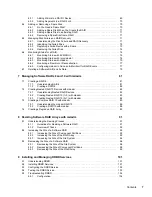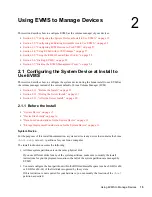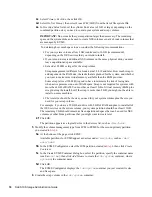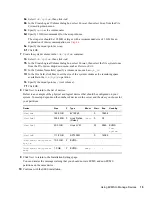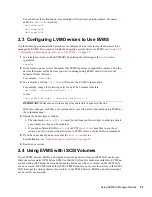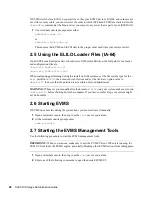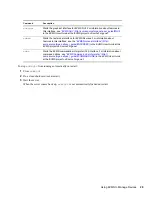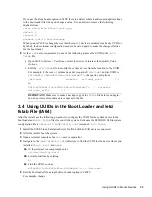
20
SLES 10 Storage Administration Guide
no
vd
ocx
(e
n)
6 Ap
ril 20
07
IMPORTANT:
After the install is complete, make sure to perform the mandatory post-install
configuration of the related system settings to ensure that the system device functions properly
under EVMS. Otherwise, the system fails to boot properly.
For information, see
“After the Server Install” on page 20
.
2.1.3 After the Server Install
After the SUSE Linux Enterprise Server 10 install is complete, you must perform the following
tasks to ensure that the system device functions properly under EVMS:
“Edit the /etc/fstab File” on page 20
“Make a New initrd” on page 21
“Disable the boot.lvm and boot.md Services” on page 21
“Enable the boot.evms Service” on page 21
“Restart the Server” on page 22
“Verify the System Services” on page 22
Edit the /etc/fstab File
When you boot the system, the kernel reads the
/etc/fstab
file to identify which file systems
should be mounted and then mounts them. This file contains a table of file system information about
the root (
/
),
/boot
, and
swap
partitions plus other partitions and file systems you want to mount.
The
/boot
partition is separate from the EVMS container where you placed the root (
/
) and
swap
partitions and is not managed by EVMS at this time. However, in the following steps, you disable
boot.lvm
and
boot.md
, then enable
boot.evms
. In effect, this forces EVMS to scan all the
partitions at boot time, including the
/boot
partition, and it activates
/boot
under the
/dev/
evms
directory. Therefore, this makes
/boot
a partition that is discovered by EVMS at startup,
and requires that the device be listed under
/dev/evms
in the
fstab
file so it can be found when
booting with
boot.evms
. You must edit the
/etc/fstab
file to modify the location of the
/
boot
partition so it is under the
/dev/evms
directory.
In
fstab
, the entry for the boot device might present the boot device by the device node name
(such as
/dev/sda1
) or by the UUID pathname (such as
/dev/disk/by-id/scsi-
SServeRA_Drive_1_600BC00000-part1
). In ether case, that name for the boot device must
be changed to include
evms
in the path, such as
/dev/evms/sda1
.
The procedure in this section shows how to change
/dev/
sda1
to
/dev/evms/
sda1
. Replace
sda1
with the device name of the device you used for your
/boot
partition.
IMPORTANT:
When working in the
/etc/fstab
file, do not leave any stray characters or
spaces in the file. This is a configuration file, and it is highly sensitive to such mistakes.
To modify the path of the boot device in the
/etc/fstab
file, complete the following procedure:
1
Open the
/etc/fstab
file in a text editor.
2
Locate the line that contains the
/boot
partition.
For example, if your
/boot
partition uses device
sda1
and the Reiser file system, look for a
line similar to this:
Содержание LINUX ENTERPRISE SERVER 10 - STORAGE ADMINISTRATION GUIDE 7-2007
Страница 4: ...novdocx en 6 April 2007...
Страница 30: ...30 SLES 10 Storage Administration Guide novdocx en 6 April 2007...
Страница 42: ...42 SLES 10 Storage Administration Guide novdocx en 6 April 2007...
Страница 58: ...58 SLES 10 Storage Administration Guide novdocx en 6 April 2007...
Страница 90: ...90 SLES 10 Storage Administration Guide novdocx en 6 April 2007...
Страница 100: ...100 SLES 10 Storage Administration Guide novdocx en 6 April 2007...
Страница 106: ...106 SLES 10 Storage Administration Guide novdocx en 6 April 2007...


